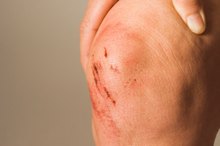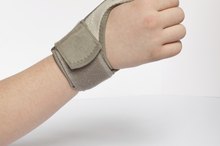A Splint for a Humerus Fracture
The humerus is the long bone located between the elbow and the shoulder joints in the upper arm.
If you are experiencing serious medical symptoms, seek emergency treatment immediately.
The humerus is made up of three different anatomic parts: the proximal humerus, the shaft and the distal humerus.
The proximal humerus is part of the shoulder joint, and the distal humerus is part of the elbow joint. The shaft of the humerus can fracture as a result of trauma, including falls, motor vehicle accidents, gunshot wounds and birth trauma. Some humeral shaft fractures occur as a result of a tumor present in the bone; these are called pathologic fractures.
The shaft of the humerus can be fractured near the shoulder, near the elbow or between the shoulder and the elbow.
Most humerus fractures are closed injuries where there is no break in the skin overlying the fracture site.
When the skin is broken during a fracture, it is known as an open fracture. Treatments for humerus fractures are typically nonoperative; however, some require surgery to improve clinical outcomes.
Indications for Splinting
Most humeral-shaft fractures are treated with an initial coaptation, splint followed by either a functional brace or a hanging arm cast. Indications for surgical repair of humeral-shaft fractures include injury to vessels, severe soft tissue injury, an open fracture where bone penetrates skin, a pathologic fracture and severe displacement of the fracture fragments.
Fractures of the proximal or distal humerus are not treated with coaptation splinting. An orthopedic surgeon or qualified healthcare provider should be consulted regarding the treatment of all humerus fractures.
- Most humeral-shaft fractures are treated with an initial coaptation, splint followed by either a functional brace or a hanging arm cast.
- Fractures of the proximal or distal humerus are not treated with coaptation splinting.
Coaptation Splint
Complications of ORIF Ankle Surgery
Learn More
A coaptation splint is a "U-shaped" splint that is placed under the axilla or arm-pit, wrapped around the elbow and terminating near the top of the shoulder. The entire length of the humerus bone is included in the splint. The splint is heavily padded. A coaptation splint is typically used for 7 to 10 days, until more definitive treatment is performed, such as with a functional brace, cast or surgery. Patients will wear a sling to help with comfort after the coaptation splint is applied.
- A coaptation splint is a "U-shaped" splint that is placed under the axilla or arm-pit, wrapped around the elbow and terminating near the top of the shoulder.
- A coaptation splint is typically used for 7 to 10 days, until more definitive treatment is performed, such as with a functional brace, cast or surgery.
Bracing
Functional bracing is typically applied 7 to 10 days after the humeral-shaft fracture, but can also be an initial option for treatment. Functional bracing and a hanging cast are the definitive nonoperative options for management of humeral-shaft fractures. The tension on the fracture brace can be adjusted to help improve alignment of the fracture fragments. The functional brace extends from just below the shoulder to just above the elbow to overlie the humerus.
It does allow for some movement to take place at the fracture site during healing. The functional brace allows for shoulder and elbow movement, which helps to maintain range of motion of these joints during the healing process of the fracture.
- Functional bracing is typically applied 7 to 10 days after the humeral-shaft fracture, but can also be an initial option for treatment.
Time Frame
Broken Wrist Complications
Learn More
Dr. Augusto Sarmiento, an orthopedic surgeon at the University of Miami, wrote an article in the "Journal of Bone and Joint Surgery" in 2000 about the effectiveness of functional bracing of humeral-shaft fractures.
A total of 922 patients with humeral-shaft fractures participated in a study conducted by Sarmiento, who discovered that average time to healing for a humeral-shaft fracture was 11.5 weeks, with a healing range from 5 to 22 weeks. The study proved that functional bracing was a definitive way to treat humeral-shaft fractures.
Side Effects
Side effects of humeral-shaft fractures treated with nonoperative methods include nonunion, malunion, nonresolution of a radial nerve palsy and infection. Vascular injuries noticed at the initial time of surgery are treated surgically.
Nonunion refers to no signs of healing of the fracture site.
Malunion refers to poor and incomplete healing of the fracture. Some deformity of the humerus is an acceptable clinical outcome.
The radial nerve can be injured at the time of injury or during the post-fracture management. Approximately 90 percent of patients who have a radial nerve palsy recover within 4 to 6 months, according to the "Handbook of Fractures." 2;
- Side effects of humeral-shaft fractures treated with nonoperative methods include nonunion, malunion, nonresolution of a radial nerve palsy and infection.
- Nonunion refers to no signs of healing of the fracture site.
Related Articles
References
- "AAOS Comprehensive Orthopaedic Review"; Dr. Jay Lieberman, ed.; 2008.
- "Handbook of Fractures"; Dr. John Elstrom, Dr. Walter Virkus, and Dr. Arsen Pankovich, eds.; 2006
- Wheeless' Textbook of Orthopaedics: Cast Brace for Humeral Frx
- Johns Hopkins University, Johns Hopkins Medicine, "Humerus Fracture (Upper Arm Fracture)"
- Cadet ER, et al. Proximal Humerus and Humeral Shaft NonunionsJ Am Acad Orthop Surg. 2013 Sep;21(9):538-47. DOI:10.5435/JAAOS-21-09-538
- Carroll EA, et al. Management of Humeral Shaft FracturesJ Am Acad Orthop Surg July 2012 vol. 20 no. 7 423-433. DOI: 10.5435/JAAOS-20-07-423 PMID: 22751161
Writer Bio
Gregory Waryasz, MD, has been a writer since 2004. His work has appeared in "Dynamic Medicine," "Athletic Therapy Today," the "Strength and Conditioning Journal" and the "Journal of the American Academy of Nurse Practitioners." He is an orthopaedic surgery resident at Brown University/Rhode Island Hospital. He has a medical doctorate from Tufts University and is certified as a strength and conditioning specialist.









